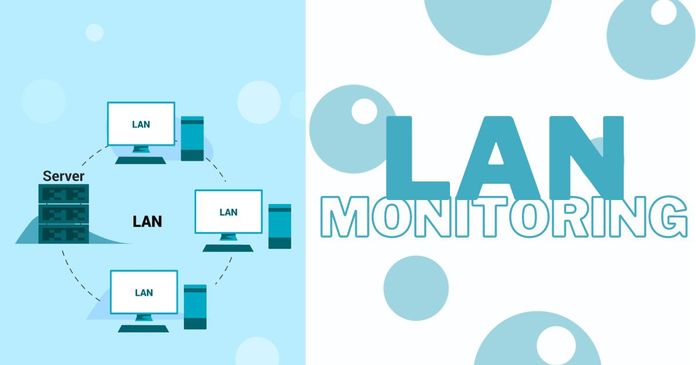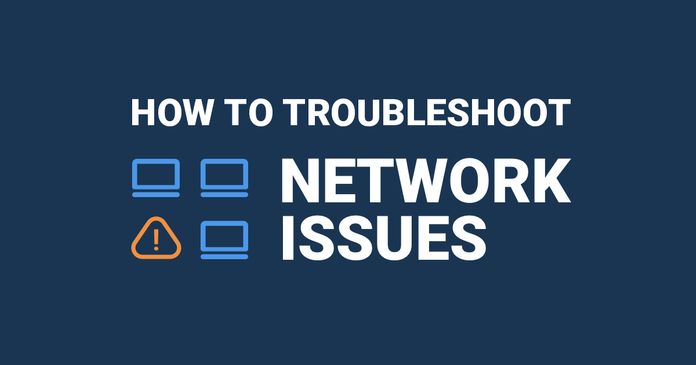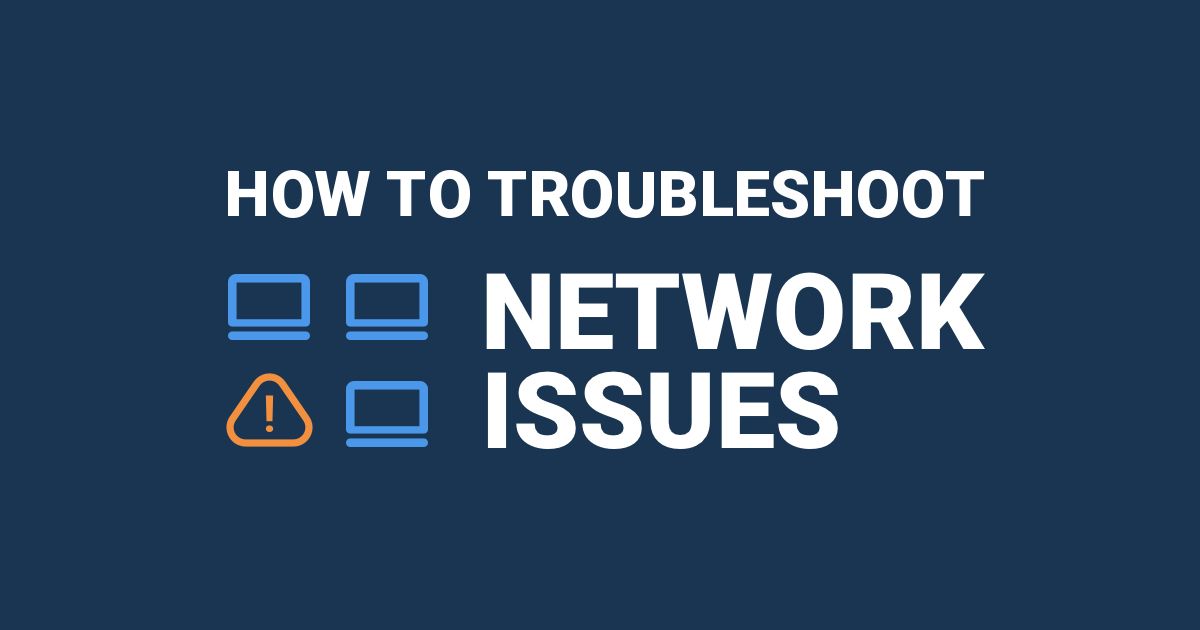Table of Contents
Table of Contents
Welcome, network admins, to an exciting exploration of how to test network performance! In the world of SaaS, Cloud computing, SD-WAN, and UC apps, a strong and reliable network infrastructure is the backbone of successful operations. Whether you're a small startup or an established enterprise, understanding how to test and optimize your network's performance is crucial for staying ahead of the competition.
In this comprehensive blog post, we'll delve into the realm of testing network performance, offering valuable insights and practical tips tailored specifically for businesses. By the end of this journey, you'll be equipped with the knowledge and tools necessary to test and enhance your network's speed, reliability, and overall efficiency.
So, fasten your seatbelts, grab a cup of coffee, and prepare to embark on a voyage that will empower you to unlock the full potential of your business network. We'll navigate through the intricacies of testing methodologies, examine key performance indicators, and discover effective strategies to identify and resolve bottlenecks.
Whether you're aiming to optimize internal communications, support remote teams, or ensure seamless customer experiences, this guide will serve as your trusted compass, pointing you toward a network performance that propels your business to new heights.
Get ready to transform your business operations by harnessing the power of a high-performing network. Let's dive in and uncover the secrets of testing network performance for your organization's success!
In this section, we will explore the why behind network performance testing—a practice that should be on the radar of every business and network administrator. By understanding the benefits and significance of testing network performance, you'll be equipped to proactively address issues, improve user experiences, and optimize your network's capabilities.
Testing network performance is vital for several compelling reasons:
- Optimal User Experience: A high-performing network ensures smooth and seamless experiences for both internal users and external customers. By testing network performance, you can identify and address issues that may cause delays, lags, or interruptions in data transmission. This translates to improved productivity, enhanced customer satisfaction, and a competitive edge in today's digitally-driven world.
- Reliable Communication and Collaboration: Effective communication and collaboration are the lifeblood of any successful business. Testing network performance allows you to ensure that your network can support the demands of real-time collaboration tools, video conferencing, file sharing, and other essential communication channels. By optimizing your network, you enable seamless connectivity and foster efficient teamwork across departments and remote locations.
- Enhanced Productivity: Slow or unreliable networks can significantly hamper productivity, leading to frustration and wasted time for employees. By testing network performance, you can identify and resolve bottlenecks, congestion, or bandwidth limitations that hinder workflow efficiency. A fast and stable network empowers employees to work more efficiently, access critical resources quickly, and meet deadlines with ease.
- Scalability and Future-Proofing: As businesses grow and evolve, their network requirements also change. Testing network performance allows you to assess the scalability of your infrastructure and identify potential limitations. By proactively addressing scalability issues, you can ensure that your network can accommodate increased data traffic, additional users, and emerging technologies. This future-proofing helps you avoid costly network upgrades or disruptions down the line.
- Security and Risk Mitigation: Network performance testing goes hand in hand with network security. By evaluating your network's performance, you can identify vulnerabilities, gaps in security protocols, or potential areas of exposure. This enables you to implement robust security measures, safeguard sensitive data, and mitigate risks associated with network breaches, unauthorized access, or data loss.
In summary, testing network performance is crucial for delivering optimal user experiences, fostering reliable communication and collaboration, improving productivity, preparing for future growth, and ensuring the security and stability of your business network. It is a proactive approach that empowers you to stay ahead in the digital landscape and maximize the potential of your organization.
Ready to take your network performance testing to the next level? Harness the power of Obkio's Network Monitoring tool to unlock the full potential of your network infrastructure!
With Obkio, you can gain real-time insights into your network's performance, identify bottlenecks, and proactively address issues before they impact your business operations. Obkio’s user-friendly interface and comprehensive monitoring capabilities make it easy for businesses and network administrators to optimize their network performance with confidence.

Don't settle for guesswork when it comes to your network's health -
- 14-day free trial of all premium features
- Deploy in just 10 minutes
- Monitor performance in all key network locations
- Measure real-time network metrics
- Identify and troubleshoot live network problems

When it comes to evaluating network performance, employing the right testing techniques is crucial. By employing various testing methods, businesses and network administrators can gain valuable insights into their network's capabilities and identify areas for improvement. In this section, we will explore different techniques for testing network performance.
When it comes to testing network performance, there are various techniques and methodologies available. Here are some commonly used techniques:
- Throughput Testing: This technique measures the amount of data that can be transmitted over the network within a given time frame. It helps determine the network's capacity and efficiency by evaluating the data transfer rate.
- Latency Testing: Latency refers to the delay between data transmission and its arrival at the destination. Latency testing measures this delay to assess the responsiveness of the network. It is crucial for applications that require real-time interactions, such as video conferencing or online gaming.
- Packet Loss Testing: Packet loss occurs when data packets fail to reach their intended destination. Packet loss testing helps identify any issues or network congestion that may result in dropped packets. It provides insights into the network's reliability and helps optimize its performance.
- Jitter Testing: Jitter refers to the variation in the delay of received packets. It can cause disruptions and inconsistencies in real-time applications. Jitter testing measures the fluctuation in packet arrival times and helps ensure stable and consistent network performance.
- Bandwidth Testing: Bandwidth testing evaluates the available network bandwidth, which determines the amount of data that can be transmitted at a given time. Measuring bandwidth helps assess if the network can handle the expected workload and supports the desired level of performance.
- Network Stress Testing: This technique involves simulating high traffic and workload conditions to evaluate how the network performs under extreme scenarios. It helps identify potential bottlenecks, performance limitations, and assesses the network's stability and resilience.
- Quality of Service (QoS) Testing: QoS testing assesses how well the network can prioritize and manage different types of network traffic, ensuring that critical applications receive the necessary bandwidth and performance. It helps optimize network resources and ensure a consistent user experience.
- Network Monitoring: Network monitoring involves continuously monitoring the network's performance, including metrics such as latency, throughput, packet loss, and more. It provides real-time visibility into network performance, network monitoring alerts for anomalies, and helps with ongoing optimization and troubleshooting.
Remember, the choice of techniques may vary based on specific requirements and objectives. It is often beneficial to employ a combination of these techniques to gain a comprehensive understanding of your network's performance characteristics and identify areas for improvement.
Active testing involves the deliberate generation of test traffic to assess the performance of the network. Here are some examples of active testing approaches:
- Ping and ICMP: Using the ICMP (Internet Control Message Protocol) echo request and reply messages, administrators can send ICMP packets to measure latency and packet loss between network devices. Ping is a commonly used tool for active testing that helps assess basic network connectivity.
- Synthetic Monitoring: Synthetic monitoring or testing involves simulating network traffic and measuring network performance by generating synthetic data packets. By configuring parameters like packet size, rate, and destination, administrators can evaluate network capacity, throughput, and latency. Synthetic Network Monitoring tools like Obkio, or tools like Iperf and Ostinato are commonly used for synthetic monitoring or testing.
- Network Stress Testing: Stress testing involves creating heavy network traffic to evaluate the network's performance under extreme conditions. By simulating high-volume scenarios, administrators can identify bottlenecks, measure resource utilization, and determine the network's capacity to handle increased loads. Tools like D-ITG (Distributed Internet Traffic Generator) and Apache JMeter can be used for stress testing.
Learn how to use synthetic monitoring to monitor network performance & identify network issues, and the benefits of synthetic traffic over packet capture.
Learn more

Passive testing involves monitoring and capturing network traffic data without actively generating test traffic. Here are some examples of passive testing approaches:
- Packet Capture and Analysis: Network administrators can use packet capture tools like Wireshark to capture and analyze network traffic. By examining packet-level details, they can identify issues such as packet loss, latency, and protocol-specific problems. Passive testing allows for real-time monitoring and retrospective analysis of network performance.
- Flow-based Analysis: Flow-based monitoring tools like NetFlow, sFlow, or IPFIX collect and analyze network traffic data at the flow level. Flows are defined by source and destination IP addresses, ports, and other attributes. Flow analysis provides insights into traffic patterns, application usage, and bandwidth utilization, helping identify potential performance bottlenecks.
- Network Performance Monitoring: Passive monitoring tools continuously collect and analyze network performance metrics, such as latency, packet loss, and bandwidth utilization. These tools provide real-time visibility into network health and performance, enabling administrators to proactively detect and troubleshoot issues.
Both active and passive testing approaches offer valuable insights into network performance. Active testing is useful for simulating specific scenarios and generating controlled traffic, while passive testing provides a broader view of the overall network behaviour and captures real-world data. A combination of active and passive testing approaches is often recommended to gain a comprehensive understanding of network performance and identify areas for improvement.
Testing network performance across multiple techniques can be a complex and time-consuming task. However, there's a simpler and more efficient way to achieve comprehensive network monitoring and testing. Enter Obkio's powerful Network Monitoring tool, designed to simplify the process and provide you with invaluable insights into your network's performance.
With Obkio, you can effortlessly perform throughput testing, latency testing, packet loss testing, jitter testing, and bandwidth testing, all from a centralized platform. Obkio’s tool offers a comprehensive suite of monitoring capabilities that empower businesses and network administrators to optimize their network's performance with ease.
Let's explore how to test network performance with Obkio, step-by-step:
Harnessing the power of a comprehensive Network Monitoring tool simplifies and streamlines the process of testing network performance. With a single solution like Obkio's Network Monitoring tool, businesses and network administrators can efficiently perform various performance testing techniques and gain deep insights into their network's health.
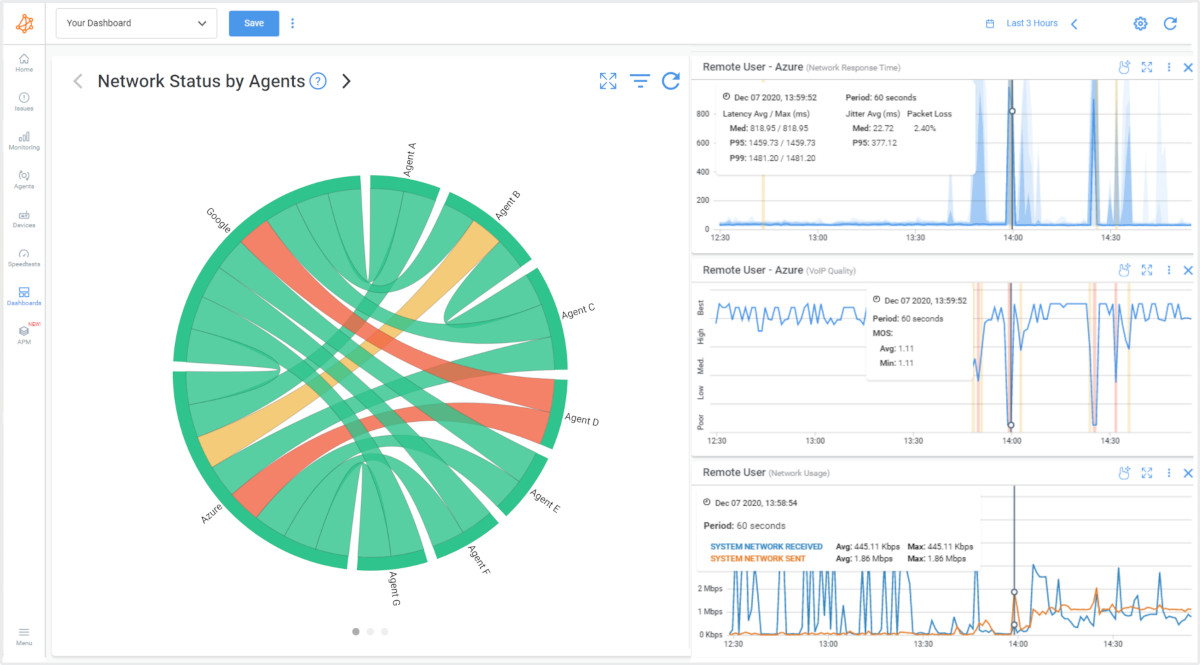
By leveraging Obkio's Network Monitoring tool, you can streamline the way you monitor and test network performance, saving time and resources while maximizing the efficiency of your network infrastructure. Take control of your network's performance today and unlock the true potential of your business with Obkio.
- Proactively identify network issues, troubleshoot problems, and ensure a seamless user experience.
- Monitoring key performance metrics in real-time to gain deep visibility into your network's health
- Get easy-to-understand visualizations, alerts for anomalies, and historical data analysis to promptly take action to address any bottlenecks or performance limitations
Say goodbye to manual testing and cumbersome troubleshooting processes -

With Obkio, testing network performance is end-to-end, which means monitoring the network's performance from the source to the destination. This comprehensive approach allows for the identification of issues across various network segments, including routers, switches, firewalls, and application servers.
This is done using Obkio’s Network Monitoring Agents. The Network Monitoring Agents are deployed at key network locations like workstations, the head office, branch offices, data centers, private clouds, public clouds, and more, and exchange synthetic traffic to monitor and test network performance.
For your initial setup, we recommend deploying:
- Local Agents: Installed in the targeted office locations where you want to test network performance. There are several Agent types available (all with the same features), and they can be installed on MacOS, Windows, Linux and more.
- Public Monitoring Agents: Deployed over the Internet and managed by Obkio. They compare and test network performance up to the Internet and quickly identify if the problem is global or specific to the destination. This will be great information for later in the troubleshooting process. You can use an AWS or Google Cloud Agent.
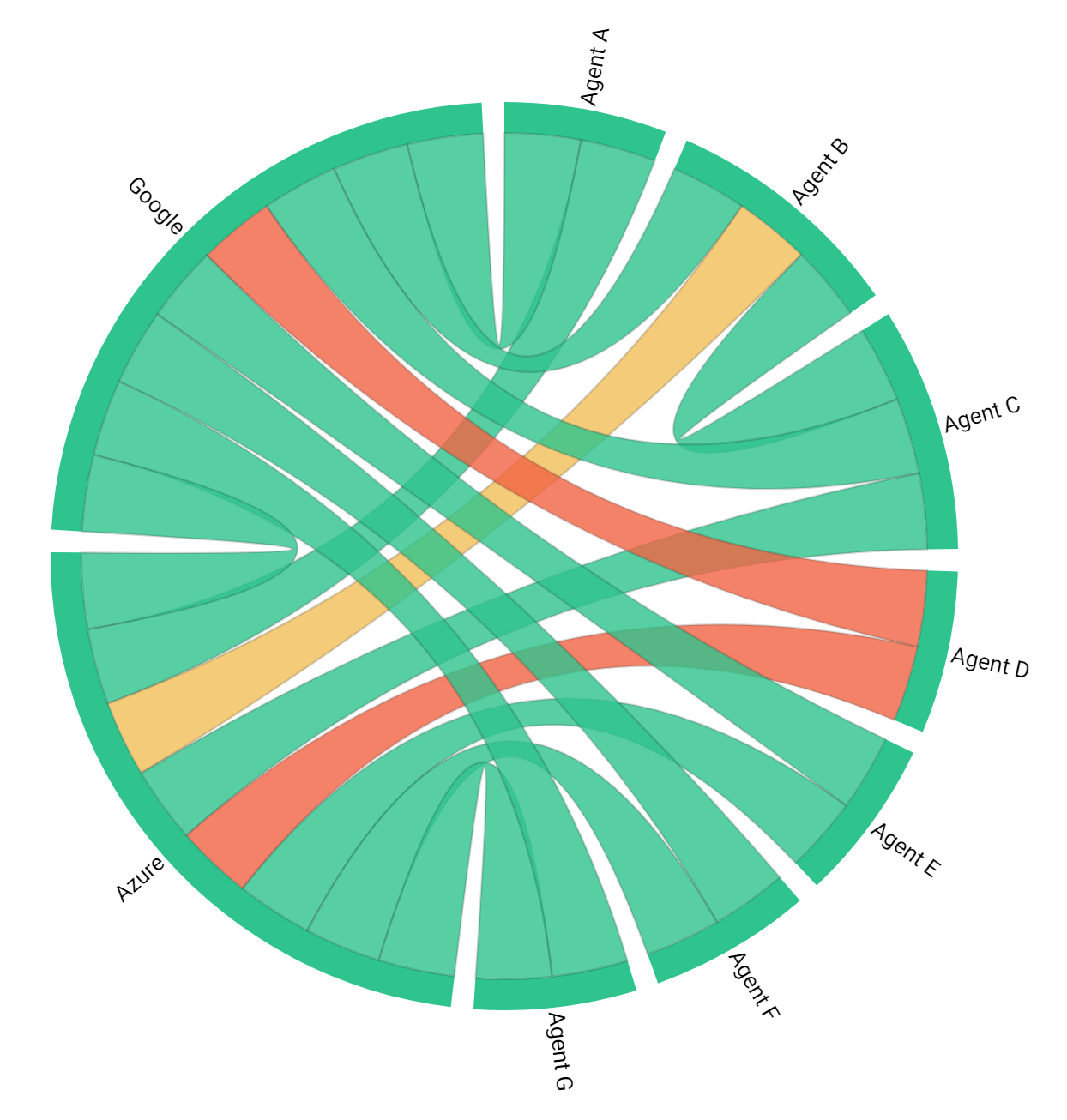
Once you’ve deployed Obkio Monitoring Agents in key network locations, they will test and measure key network metrics and display them on Obkio’s Network Response Time Graph. Testing network metrics is key for understanding the health of your network, identifying and resolving issues, ensuring a smooth user experience, and maintaining a high-performing network infrastructure.
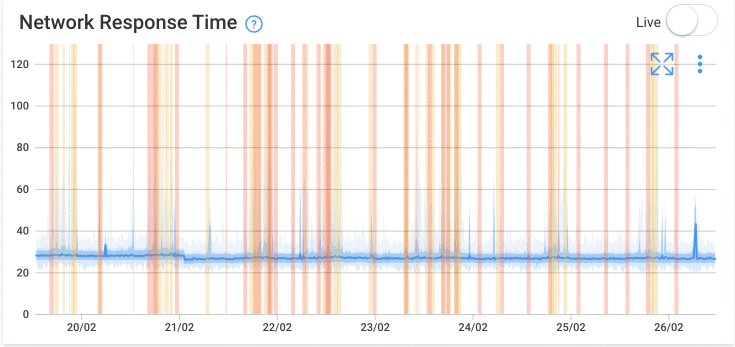
Here are some key network metrics you'll need to measure to test network performance:
- Jitter: Jitter represents the variation in the delay of received packets. It can cause disruptions and inconsistencies in real-time applications. Measuring jitter helps assess and test network stability and ensures a smooth and consistent data flow.
- Packet loss: Packet loss refers to the percentage of data packets that fail to reach their intended destination. Monitoring packet loss helps identify network congestion, faulty equipment, or other issues that may impact data integrity and application performance.
- Latency: Latency measures the delay between data transmission and its arrival at the destination. It is crucial for assessing the responsiveness of the network. Measuring latency helps identify potential bottlenecks and ensures optimal performance for real-time applications like VoIP (VoIP latency).
- Throughput: Throughput measures the amount of data that can be transmitted over the network within a given time frame. It helps evaluate the network's capacity and efficiency, ensuring it can handle the expected workload and support high-performance applications.
- Bandwidth Utilization: Bandwidth utilization measures the percentage of available network bandwidth being used. Monitoring bandwidth utilization helps identify potential congestion points and ensures that sufficient bandwidth is allocated to critical applications.
- Network Errors: Network errors encompass various types of errors, such as CRC errors, packet collisions, or interface errors. Monitoring network error rates helps identify underlying issues, such as faulty hardware or misconfigurations, which can impact network performance.
- Network Response Time: Network response time measures the time it takes for a system or application to respond to a request. It is particularly important for client-server interactions and user experience. Monitoring response time helps ensure that applications are performing optimally and meeting expected service level agreements (SLAs).
- Network Availability: Network availability measures the percentage of time that the network is operational and accessible. Monitoring network availability helps identify periods of downtime, disruptions, or outages, enabling proactive measures to minimize service interruptions.
By measuring these network metrics, businesses and network administrators can gain a holistic view of their network's performance, identify areas for improvement, and proactively address issues that may impact user experience, productivity, and overall operational efficiency.
To effectively test network performance, it is important to assess various network devices that play a crucial role in data transmission and connectivity. Here are some key network devices that should be tested:
- Routers: Routers are responsible for directing network traffic between different networks or subnets. Testing routers helps evaluate their performance in terms of routing efficiency, throughput, latency, and handling various network protocols.
- Throughput: Measure the amount of data the router can process per unit of time.
- Latency: Assess the delay experienced by data packets as they traverse the router.
- Switches: Switches facilitate communication between devices within a local network. Testing network switches can assess their capacity, throughput, latency, and ability to handle multiple concurrent connections.
- Throughput: Measure the switch's capacity to handle data traffic within the local network.
- Latency: Evaluate the delay introduced by the switch during data transmission.
- Port utilization: Monitor the usage levels of individual switch ports to identify potential bottlenecks.
- Firewalls: Firewalls provide network security by monitoring and controlling incoming and outgoing traffic. Testing firewalls help evaluate their performance impact on network speed, throughput, and latency, while ensuring that security policies and rules are properly implemented.
- Throughput: Measure the firewall's capacity to process and inspect network traffic.
- Latency: Assess the delay introduced by the firewall in analyzing and filtering data packets.
- Connection limits: Determine the maximum number of simultaneous connections the firewall can handle.
- Load Balancers: Load balancers distribute network traffic across multiple servers to optimize performance and ensure high availability. Testing load balancers help assess their ability to evenly distribute traffic, handle increased loads, and maintain network performance under heavy usage.
- Throughput: Measure the load balancer's ability to evenly distribute traffic among servers.
- Latency: Assess the delay introduced by the load balancer during the traffic distribution process.
- Server health monitoring: Monitor the load balancer's capability to detect and route traffic away from unhealthy servers.
- Wireless Access Points (WAPs): WAPs enable wireless connectivity in a network. Testing WAPs includes evaluating their coverage, signal strength, throughput, and latency to ensure optimal wireless performance and connectivity.
- Signal strength: Measure the strength and coverage of the wireless signal provided by the WAP.
- Throughput: Assess the WAP's capacity to handle wireless data transmission.
- Latency: Evaluate the delay experienced by wireless devices in connecting to the network through the WAP.
- Network Interface Cards (NICs): NICs are hardware components that connect devices to a network. Testing NICs helps ensure they operate at desired speeds, handle high data volumes efficiently, and maintain reliable network connectivity.
- Throughput: Measure the maximum data transfer rate supported by the NIC.
- Packet loss: Monitor the rate of dropped packets during data transmission.
- Error rate: Assess the occurrence of errors, such as CRC errors or alignment errors, on the NIC.
Luckily, you can do that within Obkio’s Network Monitoring application using the Network Device Monitoring feature! Network Device Monitoring uses SNMP Polling to monitor the performance of networking devices such as firewalls, routers, switches and wifi access points. It uses ultra-fast polling (every 30 seconds) to monitor network device metrics and quickly detect and diagnose network issues related to network devices.
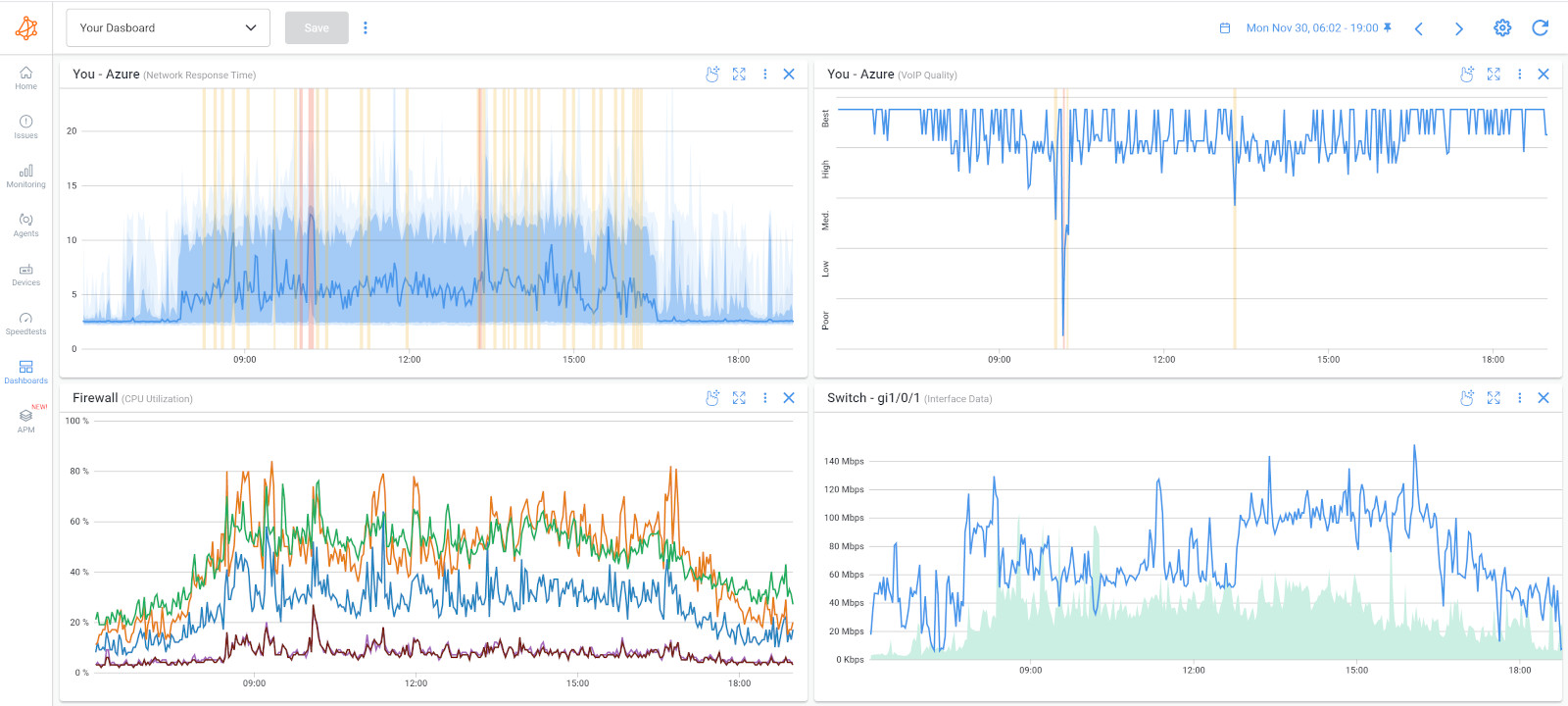
Analyzing Historical Performance Data always plays a crucial role in testing network performance as it provides valuable insights into the past behaviour and trends of the network. Obkio simplifies this process by measuring and gathering historical network performance data on your behalf.
This data enables you to analyze, compare, and troubleshoot past performance, empowering you to make informed decisions and ensure optimal network functionality.
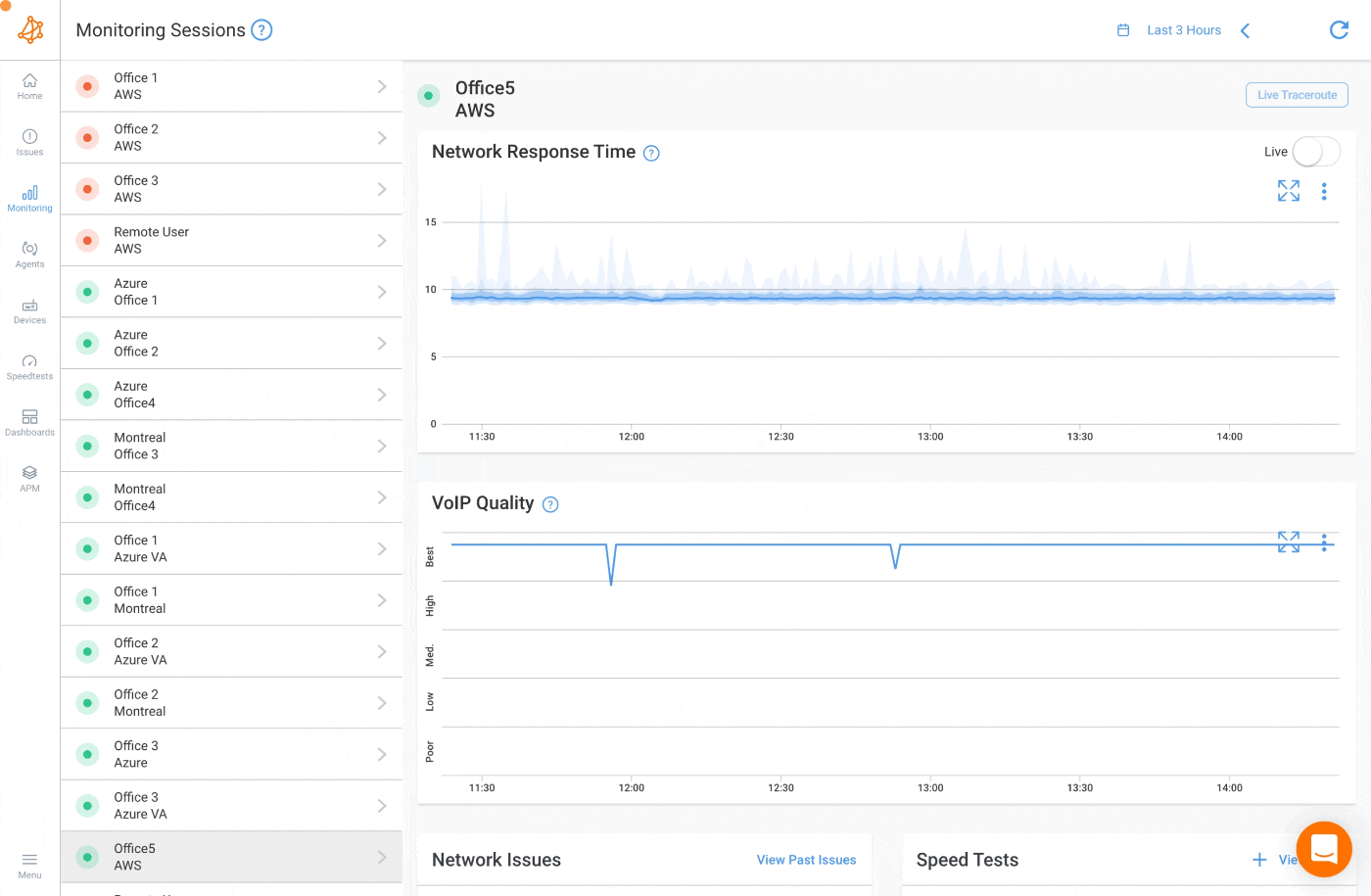
Here are some key reasons why historical data is important in network performance testing:
- Baseline Comparison: Historical data serves as a network baseline for comparison. By comparing current network performance metrics with past data, businesses and network administrators can identify deviations or anomalies that may indicate potential issues. It helps establish performance expectations and detect any significant changes or degradation in network performance over time.
- Trend Analysis: Analyzing historical data allows for trend analysis, which helps identify patterns and recurring issues. By examining performance trends, such as variations in latency, throughput, or packet loss, administrators can spot long-term patterns that might not be immediately apparent in real-time monitoring. This analysis enables proactive problem identification and resolution.
- Capacity Planning: Historical data aids in network capacity planning by providing insights into resource utilization and growth patterns. By analyzing historical trends, administrators can anticipate network traffic patterns and plan for future capacity requirements. It helps in determining when to upgrade network infrastructure, add additional bandwidth, or optimize network configurations to meet increasing demands.
- Performance Optimization: Historical data can reveal performance bottlenecks and areas for optimization. By identifying patterns of poor performance or recurring issues in historical records, administrators can pinpoint specific network segments or devices that require attention. This information enables targeted troubleshooting and optimization efforts, resulting in improved network performance.
- Compliance and Auditing: Historical data is essential for compliance purposes and network auditing. It provides a record of network performance and can be used to demonstrate adherence to service level agreements (SLAs) or regulatory requirements. Having historical data readily available simplifies the auditing process and ensures transparency in network performance reporting.


Interpreting network performance metrics is a crucial step when testing network performance. By analyzing and understanding these metrics, businesses and network administrators can gain valuable insights into the health, efficiency, and reliability of their network infrastructure.
Most importantly, network performance metrics can help you uncover hidden network issues affecting your users, applications and services - and uncovering these issues is the main goal for many businesses looking to test network performance.
When interpreting the results from your network tests, here are some metrics and network issues to look out for.
- Latency measures the delay experienced by data packets as they traverse the network. High latency can result in slow application response times and negatively impact user experience.
- When interpreting latency metrics, it is important to compare them against acceptable thresholds for specific applications or services. Additionally, analyzing latency trends over time can help identify potential network congestion or routing issues.
- Throughput refers to the amount of data that can be transmitted over the network within a given time frame. It is a measure of network capacity and determines the maximum data transfer rate.
- When interpreting throughput metrics, it is essential to consider the expected bandwidth requirements of applications or services running on the network. Low throughput may indicate network congestion, network overload or performance limitations that need to be addressed.
- Packet loss occurs when data packets fail to reach their destination. It can result from network congestion, faulty network devices, or insufficient network capacity.
- Interpreting packet loss metrics involves identifying the causes of packet loss and determining its impact on application performance. High packet loss rates can lead to data retransmission, affecting application responsiveness and user experience.
- Jitter measures the variation in packet delay. It can cause inconsistent delivery of packets, leading to disruptions in real-time applications like voice or video streaming. This is especially true of VoIP jitter.
- Interpreting jitter metrics involves assessing the stability and predictability of packet delivery. High jitter values indicate potential network instability or insufficient quality of service (QoS) measures.
- Error rates represent the occurrence of errors during data transmission, such as CRC errors or alignment errors. Interpreting network error rate metrics involves analyzing error patterns and identifying potential causes.
- High error rates may indicate issues with network devices, cabling, or interference. Addressing and reducing error rates is essential to maintain data integrity and network performance.
- Network utilization metrics provide insights into the usage levels of network resources, such as bandwidth or CPU. Interpreting network utilization involves identifying periods of peak usage and potential bottlenecks.
- High network utilization may require capacity upgrades or optimization measures to ensure sufficient resources for smooth operation.
- QoS metrics measure the performance of network services based on predefined parameters, such as latency, packet loss, and throughput.
- Interpreting QoS metrics involves comparing actual performance against defined thresholds or SLAs. Analyzing QoS metrics helps ensure that critical applications receive the necessary network resources and meet performance requirements.
A holistic view of network performance metrics, along with historical data analysis, helps identify trends, anomalies, and areas for optimization. By interpreting these metrics effectively, businesses and network administrators can make informed decisions, troubleshoot performance issues, and ensure a robust and efficient network infrastructure.
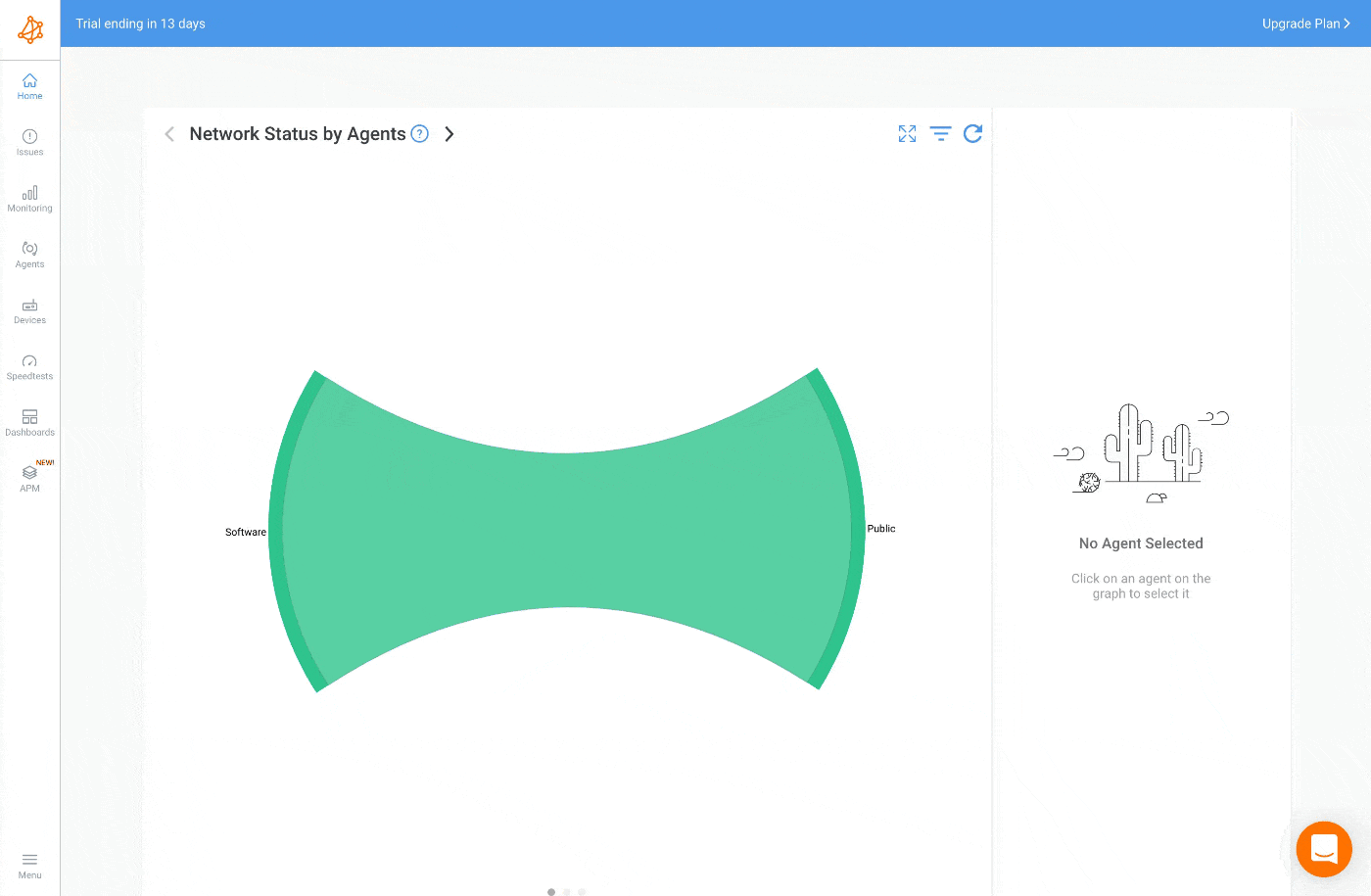

Network performance can vary significantly depending on the environment in which it is deployed. Testing network performance in different environments, such as Local Area Networks (LANs) and Wide Area Networks (WANs), is essential to evaluate the network's behaviour and optimize its performance accordingly.
Here are some key considerations when testing network performance in different environments:
Local Area Networks (LANs) typically cover a limited geographic area, such as an office building or campus. When testing network performance in LAN environments (LAN monitoring), the focus is on evaluating factors like:
- Throughput and latency: Measure the LAN's capacity to handle data transfers and the delay experienced by data packets within the LAN. Tools like bandwidth testers and latency measurement tools can assess these parameters.
- Network congestion: Evaluate the LAN's ability to handle simultaneous traffic and identify any network congestion points. Traffic analysis tools can help identify areas with high network utilization and potential bottlenecks.
- Local application performance: Test the performance of locally hosted applications and services, ensuring quick response times and reliable data transmission within the LAN.
Master LAN Monitoring: Learn the essentials, best practices, and improve LAN network performance with Obkio's Network Performance Monitoring tool.
Learn more

Wide Area Networks (WANs) span larger geographical areas and connect multiple LANs or remote locations. WAN monitoring or testing network performance in WAN environments involves considering factors like:
- Latency and network distance: Measure the round-trip time between different locations connected by the WAN. Latency can significantly impact the performance of applications and services, especially for remote users. Tools like ping tests and traceroute can provide latency and network distance measurements.
- Bandwidth and throughput: Assess the WAN's capacity to handle data transfers across remote locations. Throughput testing tools can simulate data transfers and measure the actual bandwidth available.
- Packet loss and error rates: Evaluate the WAN's reliability by monitoring packet loss and error rates during data transmission. Tools like network analyzers and protocol analyzers can capture and analyze network traffic to identify potential issues.
- WAN optimization: Test the effectiveness of WAN optimization techniques, such as compression, caching, or traffic prioritization. These techniques can help improve performance and reduce bandwidth consumption.
Many organizations operate in hybrid networks that combine LANs, WANs, and cloud-based services. Testing network performance in hybrid environments requires considering factors like:
- Network integration and connectivity: Evaluate the performance of network connections between on-premises infrastructure, remote locations, and cloud-based services. Measure latency, bandwidth, and reliability across these different components.
- Interoperability and data transfer: Test the performance of data transfers between different environments, such as on-premises systems and cloud platforms. Assess factors like data transfer speed, integrity, and any potential bottlenecks.
- Security and access control: Ensure that network security measures, such as firewalls, VPNs, or access control mechanisms, do not significantly impact performance. Test the performance of secure connections and validate the effectiveness of security measures without compromising network performance.
When testing network performance in different environments, it's essential to consider the specific requirements, configurations, and usage patterns within each environment. Realistic testing scenarios should reflect the typical workloads and traffic patterns experienced in those environments.
By testing network performance in LANs, WANs, and hybrid environments, businesses can identify performance limitations, optimize network configurations, and ensure reliable connectivity and efficient data transmission across their network infrastructure.


We’re almost at the end! Now that you know how to test network performance, and how to analyze the results, what next?
Testing network performance provides valuable insights into the current state of the network and helps identify areas for improvement. Once you’ve tested your network performance and analyzed the results, it's time to implement strategies to enhance network performance.
Here are some effective strategies based on test results:
Based on the test results, consider optimizing the network infrastructure to improve performance. Some optimization strategies may include:
- Bandwidth management: Analyze bandwidth utilization and allocate resources based on priority. Implement Quality of Service (QoS) measures to prioritize critical traffic and avoid congestion.
- Load balancing: Distribute network traffic across multiple paths or devices to evenly distribute the load. Load balancing techniques help optimize resource utilization and prevent bottlenecks.
- Network device upgrades: Upgrade network devices, such as routers, switches, or firewalls, to newer models with enhanced capabilities. This can improve performance, increase throughput, and support additional features.
- Redundancy and failover: Implement redundancy and network failover mechanisms to ensure high availability and minimize disruptions. Redundant links, backup devices, or failover configurations can improve network reliability.
Fine-tuning network configurations based on test results can significantly improve performance. Consider the following optimization strategies:
- TCP/IP parameter adjustment: Modify TCP/IP parameters, such as window size or maximum segment size, to optimize network performance based on the specific characteristics of your network.
- Protocol optimization: Optimize protocols such as TCP, UDP, or IP to minimize latency, reduce overhead, and improve overall network efficiency.
- Caching and compression: Implement caching mechanisms to store frequently accessed data closer to users, reducing latency and improving response times. Compression techniques can reduce bandwidth consumption for data transfers.
Applications and services running on the network can significantly impact performance. Based on the test results, consider the following strategies:
- Application-specific optimizations: Work closely with application developers or vendors to optimize application settings, database queries, or caching mechanisms. These optimizations can improve application performance and reduce network overhead.
- Content delivery optimization: Implement Content Delivery Networks (CDNs) or edge caching to deliver content closer to end-users, reducing latency and improving response times.
- Application performance monitoring: Continuously monitor application performance to identify bottlenecks, track response times, and detect any issues that may impact network performance.
Network performance is an ongoing process, and it's essential to continuously monitor and analyze performance metrics. Consider the following practices:
- Real-time monitoring: Implement network monitoring tools to continuously monitor network performance, collect real-time data, and proactively identify performance issues.
- Trend analysis: Analyze historical performance data to identify trends, patterns, or recurring issues. This analysis helps anticipate potential performance bottlenecks and plan for future network capacity requirements.
- Regular testing and validation: Periodically conduct network performance tests to validate the effectiveness of implemented strategies and ensure consistent network performance improvements.
Learn how to troubleshoot network issues by identifying where, what, why network problems occur with Network Troubleshooting tools.
Learn more

In conclusion, testing network performance and optimizing your network infrastructure are key to maintaining a high-performing and reliable network. Testing network performance is crucial for businesses and network administrators to ensure optimal network functionality, reliability, and user satisfaction. By implementing regular testing practices, organizations can:
- Proactively identify and address performance issues before they impact users or critical business operations.
- Optimize network infrastructure to meet the evolving demands of your organization and accommodate future growth.
- Enhance the user experience by ensuring reliable and efficient network connectivity.
- Improve network security by identifying vulnerabilities and implementing necessary enhancements.
- Optimize the performance of critical applications and services to maximize productivity and operational efficiency.
- Make informed decisions based on accurate and reliable network performance data.

Don't let performance issues slow you down! Take charge of your network and ensure optimal performance with Obkio's comprehensive Network Monitoring tool.
Ready to unleash the full potential of your network? Start for free with Obkio today and experience seamless network performance like never before.
- 14-day free trial of all premium features
- Deploy in just 10 minutes
- Monitor performance in all key network locations
- Measure real-time network metrics
- Identify and troubleshoot live network problems

Remember, a well-tested network is a happy network. Let Obkio be your partner in network performance excellence. Happy testing!


























 Obkio Blog
Obkio Blog





